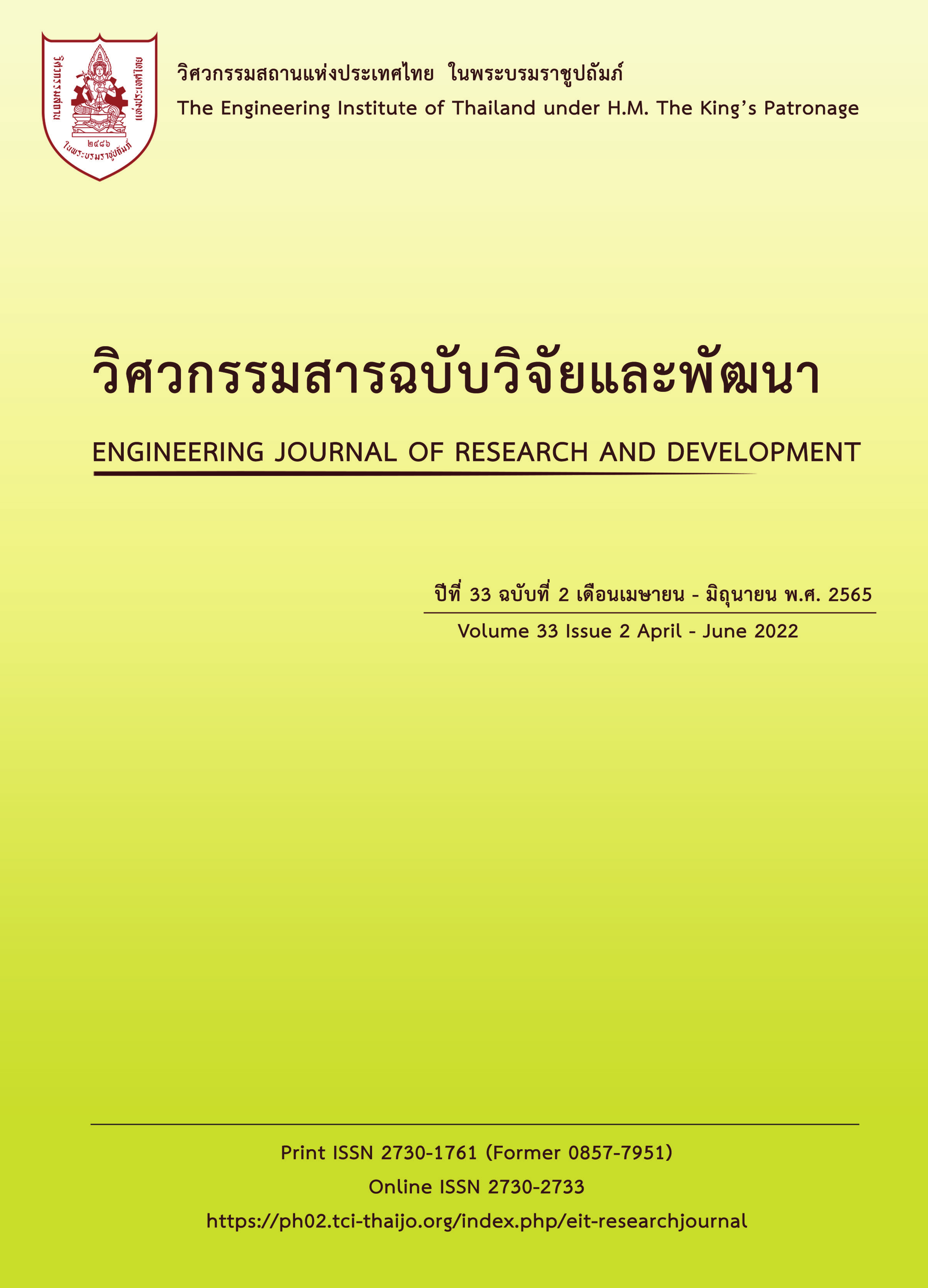COMPRESSION BEHAVIOR OF REMOLDED CEMENT-STABILIZED LOW SWELLING CLAY
Main Article Content
Abstract
The article presents the effect of cement on the index and compressive properties of remolded cement-stabilized low swelling clay. The clay sample was low plasticity clay mixed with cement at a cement content of 2 % to 6 % by weight of dry soil. The cement-stabilized low swelling clay was remolded at a curing time of 28 days. Its Index properties and 1-D consolidation were investigated. Cement content affected on index properties and compressibility properties of soil samples. The liquid limit and plastic limit of the soil sample tended to decrease with an increase in cement content. The void ratio and coefficient of consolidation of remolded cement-stabilized low swelling clay increased at particular vertical stress. For particular vertical stress, the compression index increased at optimum cement contents and has linear relationship with cement content. At the beginning, the coefficient of volume change and coefficient of permeability of the soil sample increased with an increase in cement content. The coefficient of permeability proposed by Nagaraj et al. [10] was not suitable for cement-stabilized low swelling clay. According to all consolidation test results, this paper modified the normalized equation with various swelling clay characteristics, which is useful for predicting the consolidation of other remolded clays for clay liner material in a waste landfill.
Article Details

This work is licensed under a Creative Commons Attribution-NonCommercial-NoDerivatives 4.0 International License.
The published articles are copyright of the Engineering Journal of Research and Development, The Engineering Institute of Thailand Under H.M. The King's Patronage (EIT).
References
Butterfield, R. and Baligh, F. A new evaluation of loading cycles in an oedometer. Geotechnique. 1996, 46, pp 547-553.
Burland, J. B. On the compressibility and shear strength of natural clays. Geotechnique. 1990, 40 (3), pp 329-378.
Mitchell, J.K. Fundamentals of soil behavior, New York: John Willey & Sons Inc. 1996.
Nagaraj, T.S., Srinivasa Murthy, B.R., Vasala, A. and Joshi, R.C. Analysis of compressibility of sensitive clays. Journal of Geotechnical Engineering ASCE, 1990, 116 (GT1), pp. 105–118.
Nagaraj, T.S., Pandian, N.S. and Narasimha Raju, P. S. R. Compressibility behavior of soft cemented soil. Geotechnique. 1998, 48 (2), pp 281-287.
Nagaraj, T.S. and Miura, N. Soft clay behavior: Analysis and assessment. Balkema, Rotterdam, 2001, 315.
Horpibulsuk, S., Shibuya, S., Fuenkajorn, K. and Katkan, W. Assessment of engineering properties of Bangkok Clay. Canadian Geotechnical Journal, 2007, 44 (2), pp. 173-187.
Nagaraj, T.S. and Srinivasa Murthy, B.R. A critical reappraisal of compression index equations. Geotechnique, 1986, 36 (1), pp. 27- 32.
HorpibulsuK, S., Yangsukkasem, N., Chinkulkijniwat, A. And Du, Y.J. Compressibility and permeability of Bangkok clay compared with kaolinite and Bentonite. Journal of Applied Clay Science, 2011c, 52, pp. 150–159.
Nagaraj, T.S., Pandian, N.S. and Narasimha Raju, P. S. R. Stress state - Permeability relationships for fine-grained soil. Geotechnique, 1993, 43 (2), pp. 333-336.
Prakash, K. And Sridharan, A. Free swell ratio and clay mineralogy of fine-grained soil. Geotechnical Testing Journal, ASTM, 27(2), pp. 220–225.
ASTM International. ASTM D D2435/D2435M-11-Standard Test Methods for One-Dimensional Consolidation Properties of Soils Using Incremental Loading, 2011.
Bergado, D.T., Anderson, L.R., Miura, N. and Balasubramaniam, A.S. Soft ground improvement in lowland and other environments, ASCE, New York. 1996.
Herzog, A. and Mitchell J. K. Reactions Accompanying Stabilization of Clay with Cement. In Highway Research Record 36, HRB, National Research Council, Washington, D.C., 1963, pp. 146-171.
Bergado, D.T., Anderson, L.R., Miura, N. and Balasubramaniam, A.S. Soft ground improvement in lowland and other environments, ASCE, New York, 1996.
Schaefer, V.R., Abramson, L.W., Drumheller, J.C., and Sharp, K.D. Ground improvement, ground reinforcement and ground treatment: Developments 1987 to 1997. ASCE Geotech. Special Publication, GSP, 1997, pp. 69.
Prusinski, J. R., and Bhattacharja, S. Effectiveness of Portland Cement and Lime in Stabilizing Clay Soils. In Transportation Research Record: Journal of the Transportation Research Board, TRB, National Research Council, Washington, D.C., 1999, No. 1652, pp. 215 – 227.
Horpibulsuk, S., Shibuya, S., Fuenkajoin, K.and Katkan, W. Assessment of engineering properties of Bangkok clay. Canadian Geotechnical Journal, 2007, 44 (2), pp. 173-187.
Chew, S.H., Kamruzzaman, A.H.M. and Lee, F.H. Physicochemical and engineering behavior of cement treated clays. Journal of Geotechnical and Geoenvironmental Engineering, ASCE, 2004, 130(7), pp. 696–706.
Wroth, C. and Wood, D. The correlation of index properties with some basic engineering properties of soil. Canadian Geotechnique Journal, 1978, 15 (2), pp. 137-145.
Sharma, B.and Bora, P. Plastic limit liquid limit and undrained shear strength of soil-reappraisal. Journal of Geotechnical and Geo-environmental engineering, 2003, 129 (8), pp. 774-777.
กรมควบคุมมลพิษ กระทรวงวิทยาศาสตร์และเทคโนโลยีและสิ่งแวดล้อม. เกณฑ์มาตรฐาน และแนวทางการจัดการขยะมูลฝอยชุมชน. กรุงเทพ ฯ: โรงพิมพ์คุรุสภาลาดพร้าว, 2542.


